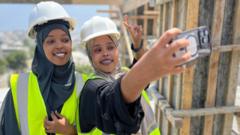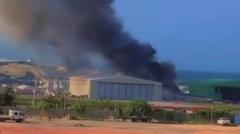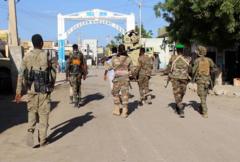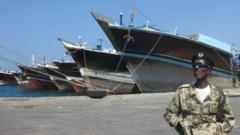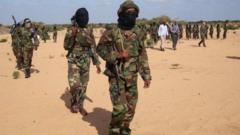The construction landscape in Somalia's capital, Mogadishu, is undergoing a remarkable transformation, not only for its infrastructure but also in the roles played by women in the industry. Amid a burgeoning skyline filled with cranes and new buildings, two remarkable young engineers, Fathi Mohamed Abdi and Saadia Ahmed Omar, are at the forefront of this change. Both just 24 years old, they have been integral to the development of a 10-floor apartment complex in the city's Hodan District, challenging societal expectations around gender roles in a traditionally male-dominated field.
Ms. Abdi, the chief operating officer of Arkan Engineering Services, expressed the skepticism she faced early in her career, stating, “When I started, people doubted me.” Despite such doubts, she and Ms. Omar, both of whom have five years of experience, focus their energies on Mogadishu’s reconstruction. “Mogadishu needs us,” Ms. Omar reminds, emphasizing their commitment to rejuvenating a city they watched struggle during the catastrophic civil war that began in 1991.
Mogadishu’s recovery from civil unrest includes an unprecedented construction boom, with over 6,000 new buildings developed in the past five years alone. Ibrahim Abdi Heyle, chairman of the Somali Engineers Association, noted that the city's pressing demand for skilled labor is gradually creating more opportunities for women in engineering roles—a significant shift given that women make up just 5% of engineers in Somalia.
The pressing need for more professionals in construction is reshaping traditional norms, with ongoing infrastructure projects creating space for women to excel. However, female engineers still face difficulties. Ms. Omar recalled her struggles landing internships, with many companies skeptical about hiring women for physically demanding jobs. “I searched for three months before someone finally gave me a chance,” she revealed.
With the reconstruction efforts leading to a highly altered urban landscape, there are some local architects voicing concerns about losing the historical character of Mogadishu. Veteran architect Siidow Cabdulle Boolaay lamented the replacement of traditional Italian-style architecture, while also raising safety issues around the construction practices. He pointed out the risks associated with using locally-sourced materials that may not meet international standards, highlighting the potential hazards facing new high-rises.
While the mayor's office claims that regulations have recently improved, some believe that ongoing construction projects are compromising quality control amid the rush to build. The growth in urban population, spurred by ongoing conflicts and climate changes, has introduced new challenges such as inadequate sewage systems and risks to groundwater supplies.
Despite the difficulties, Mogadishu’s engineers, including Abdi and Omar, remain hopeful. As they visualize the completed projects dotted across the city, they are not merely erecting structures—they are building a foundation for a new Mogadishu. “We are not just building structures; we are building hope,” says Ms. Abdi.
Both women see their roles as symbols of broader change in Somalia, proving that women can excel not only in design but also in leading complex construction projects. As Mogadishu continues its evolution, the future appears bright, with aspirations for the city to stand as a model of post-conflict recovery and resilience.

